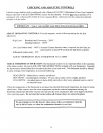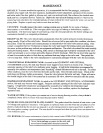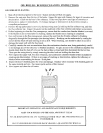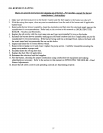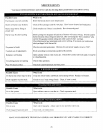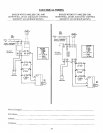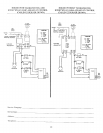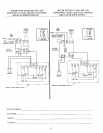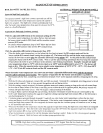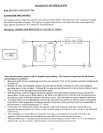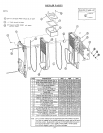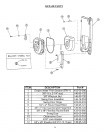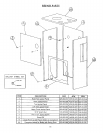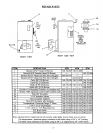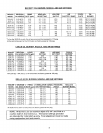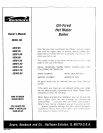
SEQUENCE OF OPERATION
BOILER WITH TANKLESS COIL:
Aquastat hiI_h limit controller:
The aquastat control's high limit contacts open and rum off the
burner when the boiler water temperature reaches the control's
high limit set point. The high limit contacts automatically reset
alter the boiler water temperature drops past the set point by 10°F,
which is a fixed_differential.
Aquastat low limit and circulator control:
With the adjustable differential at the minimum setting of 10°F:
• On a boiler water temperature rise above the low limit set point,
the burner circuit contacts (RB) break and the circulator circuit
contacts (RW) make.
• On a boiler water temperature drop of 10aF below the low limit
set point, the RB contacts make and the RW contacts break.
With the adjustable differential setting greater than 10°F:
INTERNAL WIRING FOR HONEYWELL
AQUASTAT LS124C
-- _,_=_'_ _, I 2----CN0.
ILOW LtUff/I 2 T
[_cu_roR t_
When the boiler water temperature is at (or below) the low limit set point, the RB contacts make and fire the
burner and the RW contacts break leaving the circulator off. The burner will fire until the boiler water temperature
reaches the low limit set point _ the adjustable differential setting minus 10aF. At this point the RB contacts break
stopping the burner and the RW contacts make. With no call for space heating, operating in this way keeps the circulator
off and allows the boiler to give preference to the domestic water heating requirements. Example: Consider the boiler
water temperature drops to 15OAF with the low limit set at 16OAF and the differential is set at 15°F. The burner will
begin to fire. When the aquastat probe senses a boiler water temperature of l 65aF (15°F - lOaF = 5°F, then 160°F
+5°F = 165°F) the RB contacts break and the RW contacts make.
When the boiler water temperature rises above the low limit / adjustable differential setting and the thermostat
controls call for domestic space heating. The sequence of operation for the burner and circulator is as follows:
1. Thermostat calls for heat, completing circuit between terminals T & T on the aquastat controller, energizing the 1K relay
coil.
2. With the IK relay coil energized, contacts IK1 and 1K2 are closed. Terminal B1 is energized, providing power to the oil
burner primary control. This, in turn, powers the ignition coil and burner motor.
3. With the primary control energized, the burner operation starts and remains running as long as the cad cell senses flame.
In the event of flame failure or the flame is not fully proven within the trial for ignition period, the primary control will
lockout and open the burner circuit. This will require a manual startup of the burner.
4. As long as flame is proven through the cad cell relay, the burner will remain on until the circuit is interrupted by the
boiler water temperature reaching the aquastat's high limit setting (opening high limit contacts RB), or the thermostat is
satisfied breaking the T-T circuit.
5. Circulator pump is powered through terminal C1 and will mn when boiler water temperature is above the low limit
setting and there is a call for heat from the thermostat. If the boiler water temperature reaches the aquastat's high limit
setting and high limit contact RB is de-energized, the burner stops but the circulator pump will continue to run, as long
as, the thermostat calls for heat.
6. Whenever the boiler water temperature reaches the aquastat's high limit setting, the high limit contact RB is de-energized
shutting the burner off. Then the boiler water temperature must fall 10°F below the aquastat's high limit setting for the
high limit contacts RB to close and the burner to be energized.
7 When the thermostat is satisfied, the call for domestic space heating is ended. Relay coil IK is de-energized, opening
I K I and [K2 contacts• Both the burner and circulator pump operation stop.
NOTE: High limit setting must be a minimum of 20aF higher than the low limit setting.
2



